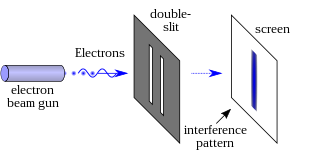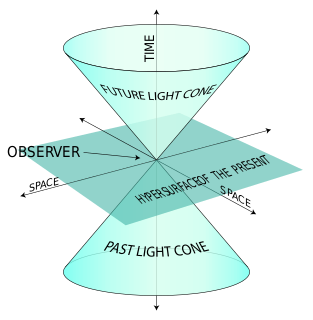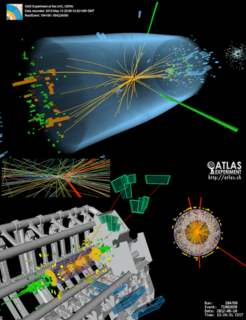Related Research Articles

In modern physics, the double-slit experiment is a demonstration that light and matter can display characteristics of both classically defined waves and particles; moreover, it displays the fundamentally probabilistic nature of quantum mechanical phenomena. This type of experiment was first performed, using light, by Thomas Young in 1801, as a demonstration of the wave behavior of light. At that time it was thought that light consisted of either waves or particles. With the beginning of modern physics, about a hundred years later, it was realized that light could in fact show behavior characteristic of both waves and particles. In 1927, Davisson and Germer demonstrated that electrons show the same behavior, which was later extended to atoms and molecules. Thomas Young's experiment with light was part of classical physics well before quantum mechanics, and the concept of wave-particle duality. He believed it demonstrated that the wave theory of light was correct, and his experiment is sometimes referred to as Young's experiment or Young's slits.

The electron is a subatomic particle, symbol
e−
or
β−
, whose electric charge is negative one elementary charge. Electrons belong to the first generation of the lepton particle family, and are generally thought to be elementary particles because they have no known components or substructure. The electron has a mass that is approximately 1/1836 that of the proton. Quantum mechanical properties of the electron include an intrinsic angular momentum (spin) of a half-integer value, expressed in units of the reduced Planck constant, ħ. Being fermions, no two electrons can occupy the same quantum state, in accordance with the Pauli exclusion principle. Like all elementary particles, electrons exhibit properties of both particles and waves: they can collide with other particles and can be diffracted like light. The wave properties of electrons are easier to observe with experiments than those of other particles like neutrons and protons because electrons have a lower mass and hence a longer de Broglie wavelength for a given energy.

In particle physics, an elementary particle or fundamental particle is a subatomic particle with no substructure, i.e. it is not composed of other particles. Particles currently thought to be elementary include the fundamental fermions, which generally are "matter particles" and "antimatter particles", as well as the fundamental bosons, which generally are "force particles" that mediate interactions among fermions. A particle containing two or more elementary particles is called a composite particle.
In theories of quantum gravity, the graviton is the hypothetical quantum of gravity, an elementary particle that mediates the force of gravity. There is no complete quantum field theory of gravitons due to an outstanding mathematical problem with renormalization in general relativity. In string theory, believed to be a consistent theory of quantum gravity, the graviton is a massless state of a fundamental string.

A neutrino is a fermion that interacts only via the weak subatomic force and gravity. The neutrino is so named because it is electrically neutral and because its rest mass is so small (-ino) that it was long thought to be zero. The mass of the neutrino is much smaller than that of the other known elementary particles. The weak force has a very short range, the gravitational interaction is extremely weak, and neutrinos do not participate in the strong interaction. Thus, neutrinos typically pass through normal matter unimpeded and undetected.

Particle physics is a branch of physics that studies the nature of the particles that constitute matter and radiation. Although the word particle can refer to various types of very small objects, particle physics usually investigates the irreducibly smallest detectable particles and the fundamental interactions necessary to explain their behaviour. By our current understanding, these elementary particles are excitations of the quantum fields that also govern their interactions. The currently dominant theory explaining these fundamental particles and fields, along with their dynamics, is called the Standard Model. Thus, modern particle physics generally investigates the Standard Model and its various possible extensions, e.g. to the newest "known" particle, the Higgs boson, or even to the oldest known force field, gravity.

The photon is a type of elementary particle. It is the quantum of the electromagnetic field including electromagnetic radiation such as light and radio waves, and the force carrier for the electromagnetic force. Photons are massless, and they always move at the speed of light in vacuum, 299792458 m/s.

A quark is a type of elementary particle and a fundamental constituent of matter. Quarks combine to form composite particles called hadrons, the most stable of which are protons and neutrons, the components of atomic nuclei. All commonly observable matter is composed of up quarks, down quarks and electrons. Due to a phenomenon known as color confinement, quarks are never found in isolation; they can be found only within hadrons, which include baryons and mesons, or in quark–gluon plasmas. For this reason, much of what is known about quarks has been drawn from observations of hadrons.
A tachyon or tachyonic particle is a hypothetical particle that always travels faster than light. Most physicists believe that faster-than-light particles cannot exist because they are not consistent with the known laws of physics. If such particles did exist, they could be used to build a tachyonic antitelephone and send signals faster than light, which would lead to violations of causality. No experimental evidence for the existence of such particles has been found.

The Standard Model of particle physics is the theory describing three of the four known fundamental forces in the universe, as well as classifying all known elementary particles. It was developed in stages throughout the latter half of the 20th century, through the work of many scientists around the world, with the current formulation being finalized in the mid-1970s upon experimental confirmation of the existence of quarks. Since then, confirmation of the top quark (1995), the tau neutrino (2000), and the Higgs boson (2012) have added further credence to the Standard Model. In addition, the Standard Model has predicted various properties of weak neutral currents and the W and Z bosons with great accuracy.

In the physical sciences, subatomic particles are smaller than atoms. They can be composite particles, such as the neutron and proton; or elementary particles, which according to the standard model are not made of other particles. Particle physics and nuclear physics study these particles and how they interact. The concept of a subatomic particle was refined when experiments showed that light could behave like a stream of particles as well as exhibiting wave-like properties. This led to the concept of wave–particle duality to reflect that quantum-scale particles behave like both particles and waves. Another concept, the uncertainty principle, states that some of their properties taken together, such as their simultaneous position and momentum, cannot be measured exactly. The wave–particle duality has been shown to apply not only to photons but to more massive particles as well.
The axion is a hypothetical elementary particle postulated by the Peccei–Quinn theory in 1977 to resolve the strong CP problem in quantum chromodynamics (QCD). If axions exist and have low mass within a specific range, they are of interest as a possible component of cold dark matter.

In physics, mass–energy equivalence is the principle that anything having mass has an equivalent amount of energy and vice versa. These fundamental quantities are directly related to one another according to Albert Einstein's famous formula:
The word mass has two meanings in special relativity: rest mass or invariant mass is an invariant quantity which is the same for all observers in all reference frames, while relativistic is dependent on the velocity of the observer. According to the concept of mass–energy equivalence, the rest mass and relativistic mass are equivalent to the rest energy and total energy of the body, respectively. The term relativistic mass tends not to be used in particle and nuclear physics and is often avoided by writers on special relativity, in favor of referring to the body's total energy. In contrast, rest mass is usually preferred over rest energy. The measurable inertia and gravitational attraction of a body in a given frame of reference is determined by its relativistic mass, not merely its rest mass. For example, photons have zero rest mass but contribute to the inertia of any system containing them.
A point particle is an idealization of particles heavily used in physics. Its defining feature is that it lacks spatial extension; being dimensionless, it does not take up space. A point particle is an appropriate representation of any object whenever its size, shape, and structure are irrelevant in a given context. For example, from far enough away, any finite-size object will look and behave as a point-like object. A point particle can also be referred in the case of a moving body in terms of physics.
Maximon is a hypothetical elementary particle of the maximum mass in the mass spectrum of elementary particles. Conversely, the lightest particle possible is called minimon.

In classical physics and general chemistry, matter is any substance that has mass and takes up space by having volume. All everyday objects that can be touched are ultimately composed of atoms, which are made up of interacting subatomic particles, and in everyday as well as scientific usage, "matter" generally includes atoms and anything made up of them, and any particles that act as if they have both rest mass and volume. However it does not include massless particles such as photons, or other energy phenomena or waves such as light or sound. Matter exists in various states. These include classical everyday phases such as solid, liquid, and gas – for example water exists as ice, liquid water, and gaseous steam – but other states are possible, including plasma, Bose–Einstein condensates, fermionic condensates, and quark–gluon plasma.

The Higgs boson is an elementary particle in the Standard Model of particle physics, produced by the quantum excitation of the Higgs field, one of the fields in particle physics theory. It is named after physicist Peter Higgs, who in 1964, along with five other scientists, proposed the Higgs mechanism to explain why particles have mass. This mechanism implies the existence of the Higgs boson. The Higgs boson was initially discovered as a new particle in 2012 by the ATLAS and CMS collaborations based on collisions in the LHC at CERN, and the new particle was subsequently confirmed to match the expected properties of a Higgs boson over the following years.
In particle physics and physical cosmology, Planck units are a set of units of measurement defined exclusively in terms of four universal physical constants, in such a manner that these physical constants take on the numerical value of 1 when expressed in terms of these units.
References
- ↑ Markov, M. A. (February 1987). "'Maximon' and 'minimon' in the light of a possible formulation of the concept of an 'elementary particle'": 115–117. Bibcode:1987PZETF..45..115M.Cite journal requires
|journal=(help) - ↑ Markov, A. A. "The maximon and minimon in light of a possible formulation of the concept of an "elementary particle"". Journal of Experimental and Theoretical Physics . Retrieved 28 July 2020.
- ↑ Markov, A. A. (1987). "THE MAXIMON AND MINIMON IN LIGHT OF A POSSIBLE FORMULATION OF THE CONCEPT OF AN 'ELEMENTARY PARTICLE.'". INSPIRE-HEP . Retrieved 28 July 2020.
- ↑ Мартынов, В. А. (2002). "ВОПРОСЫ ВЗАИМОСВЯЗИ СТРУКТУРЫ И ЭНЕРГЕТИКИ МАКРО И МИКРОМИРА: ФИЗИЧЕСКИЕ И ФИЛОСОФСКИЕ АСПЕКТЫ" (in Russian). CyberLeninka . Retrieved 28 July 2020.
| This particle physics–related article is a stub. You can help Wikipedia by expanding it. |